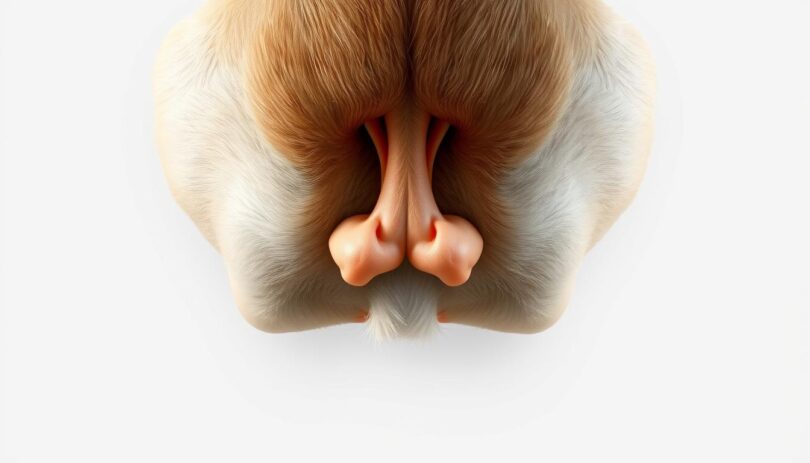Have you ever noticed your furry companion scooting across the floor or obsessively licking their hind area? These behaviors might seem odd at first, but they’re often clues pointing to a common yet overlooked issue: anal gland discomfort in pets.
Most canines naturally express their anal glands during bowel movements. However, when these small sacs near the rectum become impacted or infected, they trigger unmistakable warning signs. A sudden fishy odor, persistent scooting, or visible irritation around the rear could indicate your pet needs attention.
Understanding these symptoms early helps prevent complications. While some cases require veterinary intervention, many pet owners can learn safe at-home maintenance techniques with professional guidance. This article explores how to recognize trouble, address underlying causes, and implement preventive care strategies.
You’ll discover practical steps to support your four-legged friend’s comfort, from dietary adjustments to proper hygiene practices. Let’s demystify this sensitive topic and empower you with actionable solutions for maintaining your pet’s well-being.
Recognizing Warning Signs in Your Dog’s Rear
When pets display unusual rear-end behaviors, it’s often their way of communicating discomfort. Early detection of these signs can prevent minor issues from escalating into painful conditions requiring veterinary care.
Dragging and Strong Odors
Scooting—dragging the hindquarters across floors—is a clear signal of anal gland trouble. This action attempts to relieve pressure from full sacs near the anus. A persistent fishy or metallic smell around the area often accompanies this behavior, indicating potential impaction.
Persistent Licking and Swelling
Excessive licking or biting at the base of the tail suggests inflammation. Redness, swelling, or warmth around the anal region may point to infection. Pets might also sit awkwardly or resist touch near their rear due to pain.
If these signs appear, gently inspect the area for discharge or lumps. Consult a veterinarian if symptoms persist beyond 24 hours. Addressing issues early reduces the risk of abscesses or ruptured glands.
Exploring Common Causes Behind Anal Gland Issues
Anal gland discomfort often stems from specific triggers that disrupt normal function. While some causes are mechanical, others relate to broader health conditions. Identifying these factors helps tailor effective solutions.
Impaction, Infection, and Impacted Sac Problems
Anal sacs naturally empty during bowel movements. When this process fails, fluid thickens and blocks ducts. This impaction creates pressure, leading to inflammation and discomfort.
Bacterial infections worsen existing issues. Microbes thrive in stagnant glandular material, causing pus-filled abscesses. Pets with recurring impactions face higher infection risks without proper care.
Underlying Health Concerns and Allergies
Food sensitivities trigger chronic inflammation. Allergic reactions thicken gland secretions, making natural expression difficult. Common culprits include poultry, wheat, and artificial additives.
Other conditions like obesity or digestive disorders contribute. Excess weight reduces muscle tone, while soft stools fail to compress sacs during defecation. Hormonal imbalances and skin diseases also play roles in gland dysfunction.
At-Home Anal Gland Expression Techniques
Maintaining your pet’s anal health requires precision and care. While professional veterinary assistance remains ideal for complex cases, mild impactions may be managed at home with proper technique. This guide outlines safe methods to address gland expression needs while minimizing risks.
Step-by-Step Manual Expression Process
Prepare disposable gloves, pet-safe wipes, and a calm environment. Position your companion sideways with their tail lifted gently. Locate the glands at 4 and 8 o’clock positions around the anus.
Apply steady upward pressure using thumb and forefinger. Stop immediately if resistance occurs or your pet shows discomfort. Successful expression releases small amounts of thick fluid with minimal odor.
Proper Safety and Cleaning Measures
Always enlist a helper to keep your pet still during the process. Wash hands thoroughly before and after using antibacterial soap. Clean the anal area with hypoallergenic wipes to prevent irritation.
Discontinue home care if you notice blood, pus, or excessive redness. Pets requiring monthly manual expression should be evaluated by a veterinarian for underlying conditions. Dietary adjustments often reduce the need for frequent interventions.
Consult an animal care professional if techniques prove challenging. Many clinics offer demonstration sessions to ensure owners perform gland expression correctly and safely.
Caring for Your Dog Butt: At-Home Tips and Techniques
Proper anal care begins with understanding your pet’s natural bodily functions. Healthy anal sacs typically empty during bowel movements when firm stool applies pressure to the glands. This natural expression prevents buildup and maintains comfort in the anal area.
How Natural Expression Occurs During Defecation
Fiber-rich diets promote regular, well-formed stools that naturally compress anal sacs. Consider adding pumpkin or sweet potato to meals. These ingredients help create ideal stool consistency while supporting digestive health.
Regular hygiene practices reduce irritation risks. Use pet-safe wipes during grooming to clean the anal area without disrupting natural oils. Avoid harsh soaps that might dry sensitive skin or cause inflammation.
Monitor your companion’s behavior during bathroom breaks. Straining or frequent licking after elimination could signal gland issues. Check for redness, swelling, or unusual odors around the hindquarters weekly.
Gentle grooming prevents matted fur from blocking gland openings. Trim long hair near the rear using rounded scissors. Always reward calm behavior during grooming sessions to create positive associations.
Track changes in skin texture or coat quality near the anal region. Sudden sensitivity or hot spots warrant veterinary consultation. Early intervention prevents minor irritation from developing into infections.
Understanding Anal Gland Function and Its Behavioral Impact
Canine communication relies heavily on scent, with anal glands serving as biological identification cards. These paired sacs near the rectum produce unique secretions containing chemical markers. Healthy glands release small amounts of fluid during bowel movements or stress responses.
The Role of Anal Glands in Scent Marking
Anal gland secretions act as territorial signatures. When pets greet others, they exchange scent profiles through these oils. This instinctual behavior explains why companions sniff rear areas during social interactions.
Gland health directly impacts marking effectiveness. Overactive sacs may cause excessive scooting, while underactive ones reduce scent visibility. Regular monitoring ensures these organs function optimally for natural communication.
Why Pets Lick Their Rear Ends
Occasional licking helps maintain gland cleanliness. This grooming behavior removes residual secretions and prevents irritation. Excessive licking, however, often signals blocked ducts or inflammation requiring attention.
The tail’s position and movement correlate with gland activity. A relaxed posture allows natural secretion release, while tucked tails may inhibit this process. Observing these subtle cues helps assess overall sac health.
Proper gland function supports balanced behavior. Pets with healthy anal organs typically display confident body language and engage in normal social rituals. Addressing issues early preserves these natural interactions.
Preventative Measures to Minimize Dog Butt Problems
Proactive care significantly reduces anal gland complications. Simple lifestyle adjustments help maintain healthy gland function while lowering treatment needs over time. Focus on three key areas to support your companion’s well-being.
Nutritional Support for Optimal Function
High-fiber diets promote firm stools that naturally compress anal sacs during defecation. Add pumpkin puree or psyllium husk to meals – one teaspoon per 10 pounds of body weight daily. These supplements improve stool quality while supporting digestive health.
Hydration plays a critical role. Ensure fresh water access at all times to prevent thickened gland secretions. Pets consuming dry food benefit from moisture-rich additions like bone broth or wet food toppers.
Activity-Based Prevention Strategies
Regular exercise maintains muscle tone essential for natural gland expression. Aim for 30-minute walks twice daily, adjusting intensity based on breed and age. Overweight pets require gradual weight loss plans to reduce pressure on anal sacs.
Interactive play sessions stimulate bowel movements through physical activity. Fetch games or agility exercises encourage movement that supports digestive regularity and gland health.
Schedule biannual veterinary check-ups to assess gland condition. Professionals can identify early symptoms like minor swelling before problems escalate. Pets with recurring issues may need dietary modifications or specialized care routines.
Monitor bathroom habits and rear-end cleanliness weekly. Persistent scooting or excessive licking warrants immediate vet consultation. Combining these strategies helps minimize risks while promoting long-term anal health.
When to Consult a Veterinarian for Professional Treatment
Persistent anal gland issues demand professional expertise to prevent dangerous complications. While mild cases might respond to at-home care, certain symptoms indicate deeper health problems requiring immediate veterinary attention.
Identifying Severe Symptoms and Urgent Signs
Blood in secretions or sudden swelling around the rear signals potential abscess formation. Pus discharge often indicates advanced infections needing antibiotic treatment. Pets showing lethargy, loss of appetite, or fever alongside anal discomfort require urgent evaluation.
Persistent foul odors despite cleaning suggest chronic impaction or bacterial overgrowth. Vets use specialized techniques to assess gland health, including internal palpation and fluid analysis. These methods identify problems that home care can’t address, like tumors or duct blockages.
Medical Interventions and Surgical Options
Veterinarians may prescribe anti-inflammatory medications or antibiotics for infected glands. Severe recurrent cases sometimes require surgical removal of the anal sacs – a procedure reserved for pets with frequent abscesses or treatment-resistant issues.
Owners should avoid attempting manual expression on inflamed glands, as improper pressure can rupture sensitive tissues. For pets experiencing concurrent digestive issues, dietary changes often complement medical treatments to restore gland function.
Schedule an appointment immediately if symptoms persist beyond two days or worsen suddenly. Early intervention reduces recovery time and prevents systemic infections that could endanger your companion’s health.
Final Insights for a Healthy Rear End
A healthy rear end is crucial for your pet’s overall well-being and daily comfort. Regular observation of their behavior and physical condition helps catch issues early. Look for subtle changes like excessive licking, unusual odors, or altered bathroom habits.
High-fiber diets and consistent exercise remain foundational for preventing gland problems. These practices support natural secretion processes while maintaining ideal body weight. Pair these with routine veterinary checks to address minor concerns before they escalate.
If you notice persistent inflammation or swelling near the anal area, consult a professional immediately. These symptoms often indicate infections needing medical treatment. Early intervention prevents complications like abscesses or chronic discomfort.
Remember: informed care creates happier companions. By combining preventative strategies with prompt action, you ensure your furry friend stays comfortable and thriving. Their quality of life reflects the attention you give to these essential health details.
FAQ
What symptoms suggest anal sac problems in pets?
Scooting across floors, persistent foul odors near the rear, excessive licking of the anal area, or visible swelling may indicate impacted glands or infections. Discomfort during sitting or defecation also warrants attention.
Can diet influence anal gland health?
Yes. Low-fiber diets often lead to soft stools, which prevent natural gland expression during bowel movements. Adding pumpkin or vet-approved fiber supplements can improve stool consistency and reduce impaction risks.
Is at-home gland expression safe?
Manual expression requires proper training to avoid injury or infection. Veterinarians typically recommend leaving this procedure to professionals unless owners receive explicit guidance. Improper technique may worsen inflammation.










Leave a Comment